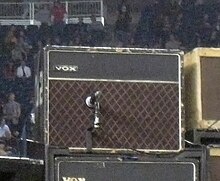Vox amplification

VOX Amplification is a music accessories manufacturer headquartered in Milton Keynes , England . The Vox brand is particularly famous for its AC30 guitar amplifier and the Vox Continental organ .
Company history
The company's history begins with the founding of the Jennings Organ Company by Tom Jennings after the Second World War. At that time an electric organ, the Univox, was being made. In 1956, Dick Denney, a former colleague of Jennings' during the war, approached him and showed him his prototype of a guitar amplifier. The name of the company changed to Jennings Musical Instruments (JMI) and in 1958 the 15 watt guitar amplifier Vox AC15 came onto the market. Music groups like The Shadows and other British rock 'n' roll musicians began to use this model.
In 1959, sales came under pressure as a serious competitor appeared with the more powerful Fender Twin. In response, Vox developed the 30 watt AC30 . The AC30, which was equipped with Celestion “Blue Alnico” loudspeakers and the Vox “Top Boost” circuit, played a major role in the development of the special sound of the so-called British Invasion . Among the best-known groups that used amplifiers from the VOX company were a. The Shadows , The Beatles , The Who and the Yardbirds . Later, musicians like Brian May from Queen or Paul Weller from The Jam discovered the AC30.
In 1962, Vox introduced the Phantom pentagonal guitar built by the Italian company EKO . The Vox Phantom Mark III model followed a year later with a teardrop-shaped body ; the prototype of which was later played by Brian Jones of the Rolling Stones .
In 1964 Jennings sold shares in JMI to the Royston Group, and he also sold the American rights to the Thomas Organ Company. They produced their own developments of mostly inferior (transistor) amplifiers for the American market instead of, as hoped, selling the British Vox amplifiers in America. Jennings left the company in 1967, around the time Marshall became the dominant force in the UK guitar amplifier market instead of Vox. In 1969 Royston went bankrupt and the company went through a phase of changing names and ownership. Expenses were reduced, especially in the production of the AC30: Cheaper loudspeakers with inferior magnets were used as well as printed circuits, and chipboard also replaced the more expensive plywood in the construction of the cabinet.
The naming rights to Vox Amplification Ltd were acquired in 1992 through the takeover of what was then Vox sales from KORG . Then a new edition (“Reissue”) of the AC30 was released. Since then, guitar amplifiers have also been developed quite successfully under the brand name Vox, which use what is known as digital modeling technology - a process that is based on the mathematical simulation of physical properties of electronic components or assemblies. These guitar amplifiers are able to emulate different types of guitar amplifiers, each with a characteristic sound .
Electronic organs and effects units
The Vox brand also stands for electronic organs, to be mentioned here e.g. B. the 1962 Vox Continental, and guitar effects machines (including an early version of the wah-wah ). The sound of the Continental is kept alive in sampled form in newer keyboard instruments. The original instruments are also still traded; in their time they were already in the upper class (below the quality of the Hammond organ , higher than Farfisa ).
Well-known amplifier series
- AC series
Even if the AC30 is the best-known type of this series today, the AC15 from 1958 is the original type of this series. In principle, it should also be noted that amplifiers with the same name have considerable differences in material and circuit depending on the time of manufacture.
- AGA series
The AGA series is an amplifier primarily developed for acoustic guitars. There was already a Vox for acoustic guitar in the 1980s. The AGA series, available since 2010, offers the option of using a tube preamp. The output stage is designed as a transistor amplifier.
- Pathfinder series
The Pathfinder series has been selling various transistor amplifiers in the lower price segment since 1999.
- VT and VR series
The technology called Valve Reactor is based on a pre-stage circuit developed by Korg in Japan in the 1980s. In 2001 this technology was offered for the first time in the VT series. The VR series is a modeling amplifier with this circuit that was delivered from 2005 to 2006.
- Battery Escort - DA and mini series
As early as the early 1970s, Vox offered a battery-powered amplifier with the Battery Escort. The mini series are battery-operated transistor amplifiers that have been available since 2010. They replaced the conceptually similar DA series.
- Night Train series
The Night Train series are tube amplifiers in the so-called lunch box format with relatively low power (2 W / 15 W) that were manufactured between 2009 and 2013.
literature
- 60 years of VOX. PPVMedien, Bergkirchen 2017. (ppvmedien.de)
Web links
- Vox Amplification (English)
- Vox sales Germany / Austria
- Guitar & Bass: Vox Amps
- detailed data Vox Continental organ (English)
- North Coast Music: Vox Showroom (English)



